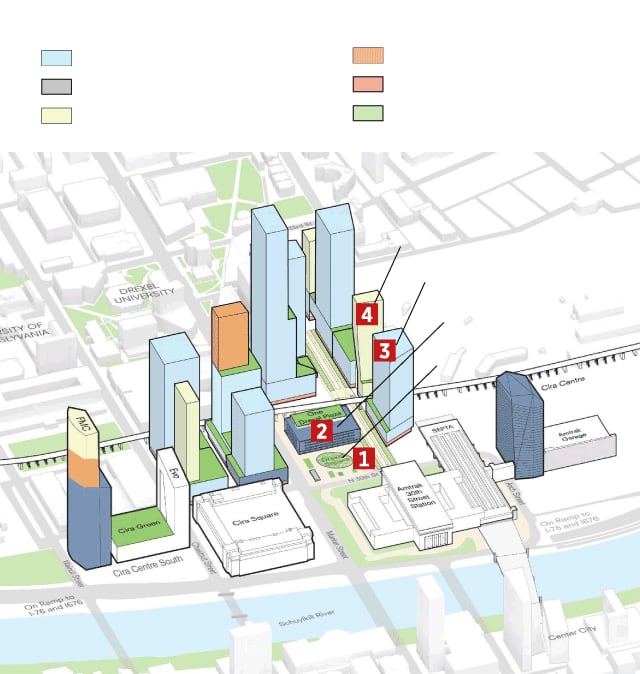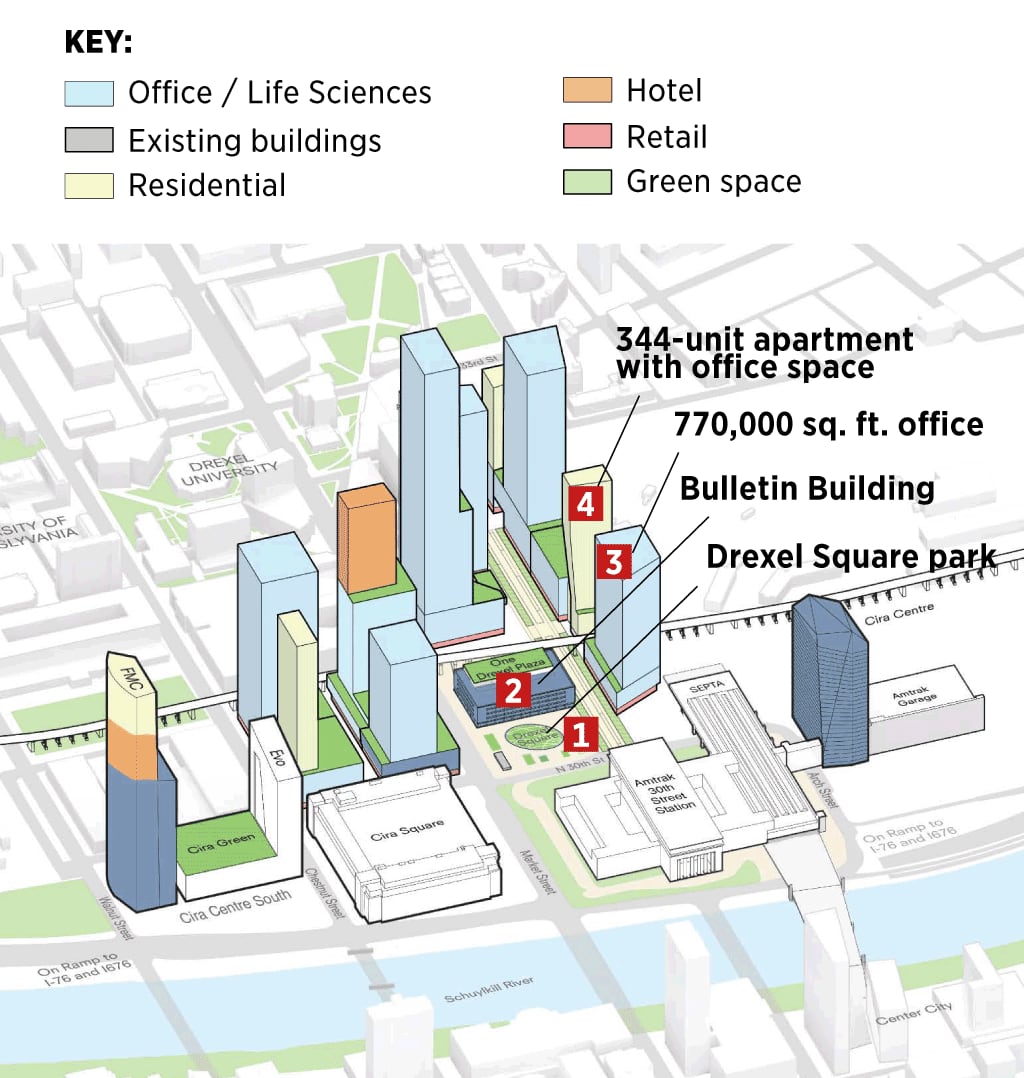Schuylkill Yards’ first project: Turning a parking lot into a park | Inga Saffron
The grounds are a nice place for a stroll, but a corporate mission clearly informed the design.
/cloudfront-us-east-1.images.arcpublishing.com/pmn/LTXXRZVTWFEZDPVCQ5EKV5BTKE.jpg)
Sometime over the last few decades, city governments stopped building new city parks and passed on the task of designing, funding, and maintaining public space to nonprofits, mainly business improvement districts, independent development agencies, and civic associations. Most of the recent parks we’ve come to love in Philadelphia — Dilworth, Schuylkill River Trail, Race Street Pier, the Rail Park, Julian Abele Park — would not exist without their efforts.
Philadelphia’s newest park, Drexel Square, takes that trend to the inevitable next level. The 1.3-acre refuge across from 30th Street Station was built from scratch by a private company, Brandywine Realty Trust. While Drexel Square looks and acts like a public park, it’s really a tool for corporate placemaking. As the first completed project in Brandywine’s ambitious Schuylkill Yards development, the park is meant to help Brandywine’s future collection of offices and apartments cohere into a neighborhood.
Like many people who care about the role that public space plays in supporting democratic society, I have mixed feelings about Drexel Square’s origins. The park, built on land leased from Drexel University (hence the name), can be seen as another example of government’s retreat and the privatization of everything. Brandywine wasn’t obliged to hold any of those annoying outreach meetings in which the public gets to offer its two cents. There are no rules about when the park can be closed to the public or whether Brandywine can exclude political protesters. One imagines it as a setting for many corporate events.
And yet Brandywine should be applauded for kicking off its massive Schuylkill Yards project with a park, quite an expensive one at that. Developers usually wait until the rent checks start flowing before they subsidize amenities. Brandywine sunk $14.3 million into creating Drexel Square. It used that generous budget to hire two top-tier urban designers, West 8 and SHoP Architects, and to ring the park with a spectacular array of 30-foot-tall dawn redwoods, creating a patch of alpine forest in West Philadelphia. Brandywine also gets extra points for reclaiming a former parking lot, and for helping to soften the auto-dominated speedway around the train station.
There’s a long history, of course, of companies investing in greenery around their buildings. When Children’s Hospital opened its Roberts Pediatric Research building on the South Street Bridge in 2017, it made a big deal about inviting the public to enjoy the entrance plaza and promenade overlooking the Schuylkill. The grounds are a nice place for a stroll, but a corporate mission clearly informed the design. Because you’re always aware of being on someone else’s property, it doesn’t feel like a true city park.
Drexel Square does. The park occupies a full block along 30th Street, between Market and JFK Boulevard, in front of a four-story office that once housed the Evening Bulletin newspaper. Brandywine is making the 1954 building, designed by George Howe, the flagship of its Schuylkill Yards project. Two new towers, including one with apartments, will soon break ground on JFK Boulevard, giving Drexel Square a northern edge and full-time neighbors. The park has entrances on every side, making it easy to visit or simply use as a shortcut on the way to someplace else.
Perhaps another reason it evokes a city park is that it looks like one, or, rather, what Philadelphia parks have become. Anyone who has spent time in the new versions of Dilworth and Love Parks will recognize the formula: Large granite plaza. Geometrically shaped lawn. Cafe tables.
Like that duo around City Hall, Drexel Square was designed for flexibility. It’s a blank canvas where you can eat lunch during the day, attend a concert or a movie in the evening, or browse a farmer’s market on the weekend.
The placemaking movement of the last two decades has emphasized this sort of activation, with the result being that many of our parks are starting to take on a generic look. They have none of the cozy nooks you find in a park like Rittenhouse Square. Charles Birnbaum, president of the Cultural Landscape Foundation, calls the design trend “splash-pad urbanism.”
While Drexel Square has no splash pad, or any water feature for that matter, it does have an elliptical grassy mound in the center, crisscrossed with narrow, granite pathways. The mound is an odd feature: It’s too small to feel like a lawn where you can spread out a blanket. Yet it takes up a disproportionate amount of the park’s total real estate.
In the architectural renderings, people sprawl across the lawn, perhaps picnicking or waiting for movie night to start. But in real life — at least during the rain-free lunch hour I spent there this week — visitors seemed reluctant to venture onto the mound. Instead, the lawn functioned like a barrier, forcing people to walk around it. Perhaps that will change as more people discover Drexel Square, which opened June 10.
The park’s furniture is almost as odd as the elliptical lawn. In what seems like an attempt to get away from the now-ubiquitous, two-person cafe tables found in so many parks, Drexel Square was outfitted with square, gray versions accompanied by bright-yellow umbrellas. Together they evoke a food court in a suburban mall.
What saves the design is the trees. The dawn redwoods are huge, far bigger than the starter trees you generally see in new parks. Each specimen weighs 25,000 pounds. Even though Drexel Square sits on a steel platform over an Amtrak spur, Brandywine felt the large trees were essential to the design. But creating a healthy environment for such behemoths turned out to be a major challenge.
Since the trees couldn’t be placed in the ground, the architects designed enormous planters to hold them, softly curving forms that incorporate granite benches. But midway through construction, Brandywine discovered that the steel platform needed to be reinforced. Despite the added cost and delays, Brandywine stuck with the big trees. Jerry Sweeney, Brandywine’s chief executive, told me he was committed to having the park look filled in on opening day.
Dawn redwoods are an unusual choice for a Philadelphia park. With their thick trunks and conical shape, they put you in the mind of a mountain woodland. Here, their size helps them stand up to the monumental presence of 30th Street Station. They also block the sound of the traffic. Thanks to their dense formation along 30th Street, Drexel Square cocoons you from the bustle of the city, which is what an urban park is supposed to do.
If I hadn’t had a deadline, I could have wasted a lot of time sitting on the lip of the planters, under the boughs of a dawn redwood, watching SEPTA trains glide into 30th Street. It’s as good a place as any to ruminate on how our cities build parks in the 21st century.
Schuylkill Yards Plans Move Forward
Two years after Brandywine Realty Trust first sketched out plans for its Schuylkill Yards innovation district, things are taking shape. One of its four projects was recently completed. 1) Drexel Square park opened June 10. 2) Kieran Timberlake has been hired to give the former Evening Bulletin Building a modern make-over. 3) Brandywine will break ground this winter on a 770,000-square foot office tower designed by PAU Studio. 4) It will also start work next door on a 344-unit apartment building with 200,000 square of office space.
KEY:
Office / Life Sciences
Existing buildings
344-unit apartment with office space
Residential
Hotel
Retail
Green space
770,000 sq. ft. office
Bulletin Building
Drexel Square park

KEY:
Hotel
Office / Life Sciences
Retail
Existing buildings
Green space
Residential
344-unit apartment with office space
770,000 sq. ft. office
Bulletin Building
Drexel Square park
